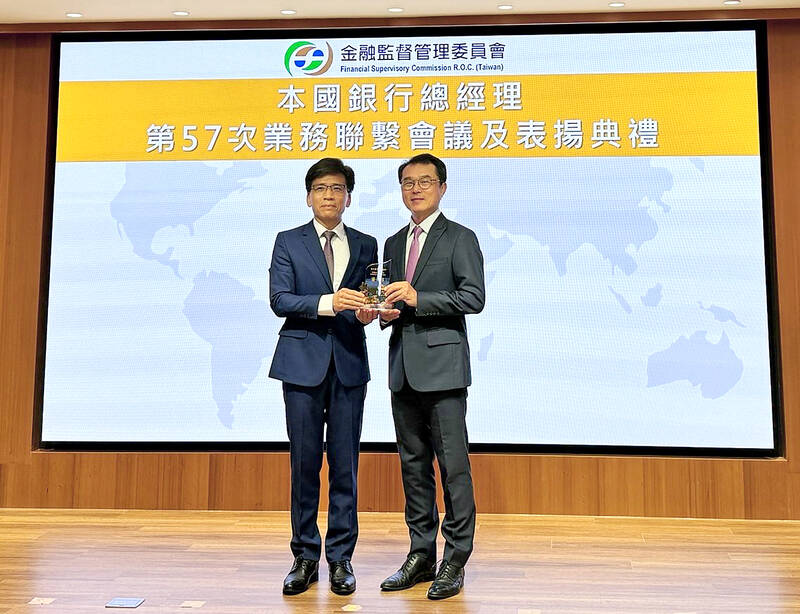Taiwanese banks extended NT$150.3 billion (US$4.63 billion) in new loans to nations included in the government’s New Southbound Policy (NSP) during the first four months of this year, led by lending to India and Australia, data compiled by the Financial Supervisory Commission showed earlier this month.
The figure is 1.8 times the NT$83.9 billion in new loans to the NSP nations recorded for the whole of last year and 2.37 times the commission’s annual new loan target of NT$63.4 billion for this year, indicating a steady recovery in fund demand in those markets, the regulator said.
The policy, introduced in 2016, is designed to enhance trade and exchanges between Taiwan and 18 nations in Southeast Asia, South Asia and Oceania: Australia, Bangladesh, Bhutan, Brunei, Cambodia, India, Indonesia, Laos, Malaysia, Myanmar, Nepal, New Zealand, Pakistan, Philippines, Singapore, Sri Lanka, Thailand and Vietnam.

Photo courtesy of Taipei Fubon Commercial Bank
Local banks have in the past few years not only increased lending to clients expanding operations in those nations, but also launched new branches or representative offices in the countries in hopes of attracting more business opportunities.
In April, the commission approved Far Eastern International Bank’s (遠東銀行) application to set up a branch in Singapore and permitted O-Bank Co (王道銀行) to launch a representative office in Sydney, Australia, after in February allowing Taipei Fubon Commercial Bank (台北富邦銀行) to open a branch in Mumbai, India.
During the first four months of this year, new loans to India totaled NT$80.2 billion, topping all other NSP nations, followed by Australia with NT$32 billion, Singapore with NT$18.2 billion and Vietnam with NT$13.1 billion, commission data showed.
By individual banks, Taipei Fubon was the most active with new loans of NT$18.9 billion in the first four months, ahead of CTBC Bank’s (中國信託銀行) NT$18 billion and Bank SinoPac’s (永豐銀行) NT$10 billion, followed by Taishin International Bank (台新銀行) with NT$9.7 billion and Chang Hwa Commercial Bank (彰化銀行) with NT$9.3 billion, the data showed.
Overall, Taiwanese banks’ outstanding loans to the 18 nations at the end of April totaled NT$1.74 trillion, the data showed.

CHIP RACE: Three years of overbroad export controls drove foreign competitors to pursue their own AI chips, and ‘cost US taxpayers billions of dollars,’ Nvidia said China has figured out the US strategy for allowing it to buy Nvidia Corp’s H200s and is rejecting the artificial intelligence (AI) chip in favor of domestically developed semiconductors, White House AI adviser David Sacks said, citing news reports. US President Donald Trump on Monday said that he would allow shipments of Nvidia’s H200 chips to China, part of an administration effort backed by Sacks to challenge Chinese tech champions such as Huawei Technologies Co (華為) by bringing US competition to their home market. On Friday, Sacks signaled that he was uncertain about whether that approach would work. “They’re rejecting our chips,” Sacks

Taiwan’s exports soared 56 percent year-on-year to an all-time high of US$64.05 billion last month, propelled by surging global demand for artificial intelligence (AI), high-performance computing and cloud service infrastructure, the Ministry of Finance said yesterday. Department of Statistics Director-General Beatrice Tsai (蔡美娜) called the figure an unexpected upside surprise, citing a wave of technology orders from overseas customers alongside the usual year-end shopping season for technology products. Growth is likely to remain strong this month, she said, projecting a 40 percent to 45 percent expansion on an annual basis. The outperformance could prompt the Directorate-General of Budget, Accounting and

BARRIERS: Gudeng’s chairman said it was unlikely that the US could replicate Taiwan’s science parks in Arizona, given its strict immigration policies and cultural differences Gudeng Precision Industrial Co (家登), which supplies wafer pods to the world’s major semiconductor firms, yesterday said it is in no rush to set up production in the US due to high costs. The company supplies its customers through a warehouse in Arizona jointly operated by TSS Holdings Ltd (德鑫控股), a joint holding of Gudeng and 17 Taiwanese firms in the semiconductor supply chain, including specialty plastic compounds producer Nytex Composites Co (耐特) and automated material handling system supplier Symtek Automation Asia Co (迅得). While the company has long been exploring the feasibility of setting up production in the US to address

OPTION: Uber said it could provide higher pay for batch trips, if incentives for batching is not removed entirely, as the latter would force it to pass on the costs to consumers Uber Technologies Inc yesterday warned that proposed restrictions on batching orders and minimum wages could prompt a NT$20 delivery fee increase in Taiwan, as lower efficiency would drive up costs. Uber CEO Dara Khosrowshahi made the remarks yesterday during his visit to Taiwan. He is on a multileg trip to the region, which includes stops in South Korea and Japan. His visit coincided the release last month of the Ministry of Labor’s draft bill on the delivery sector, which aims to safeguard delivery workers’ rights and improve their welfare. The ministry set the minimum pay for local food delivery drivers at